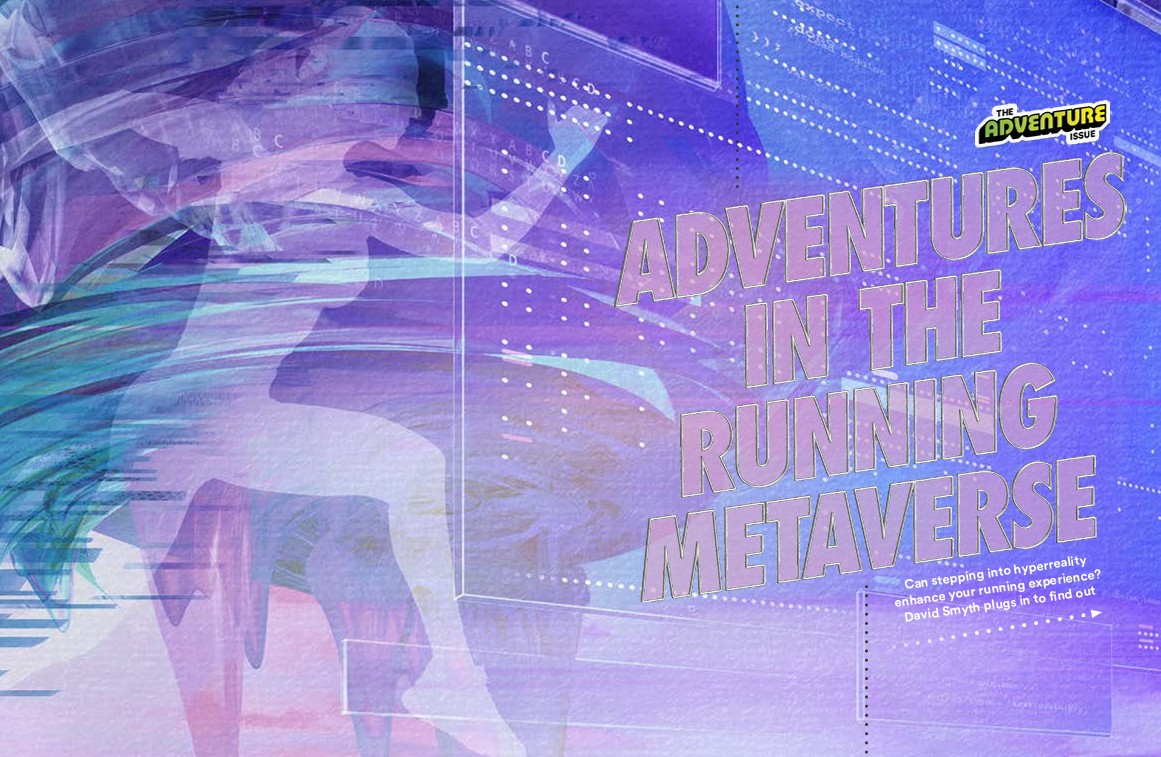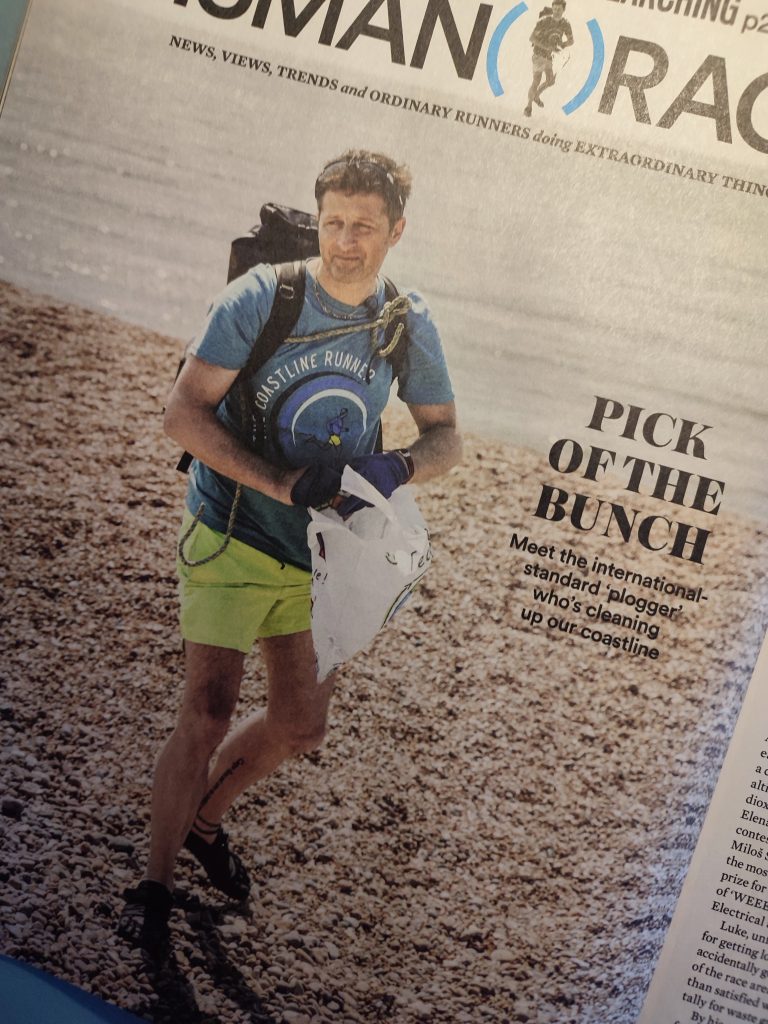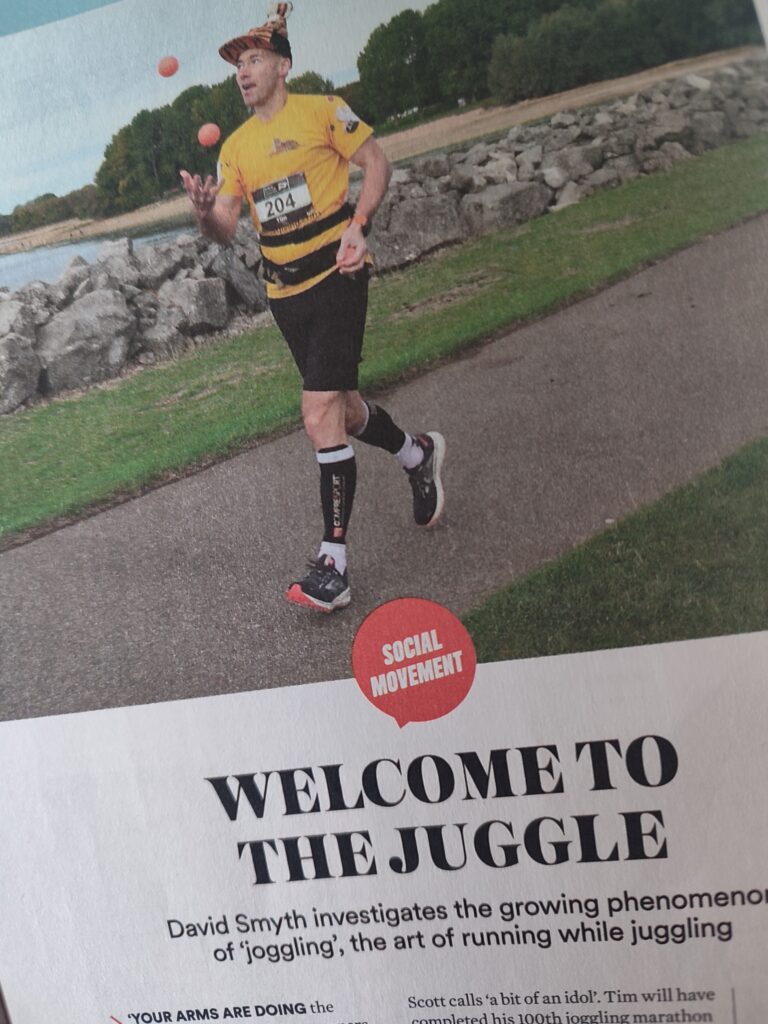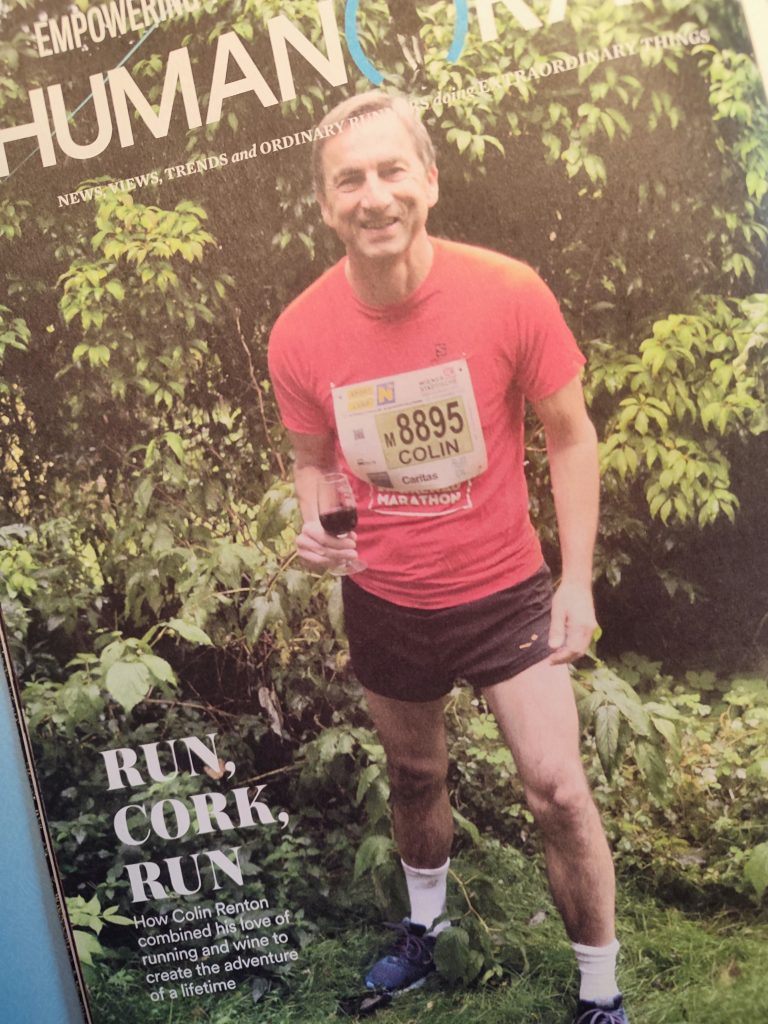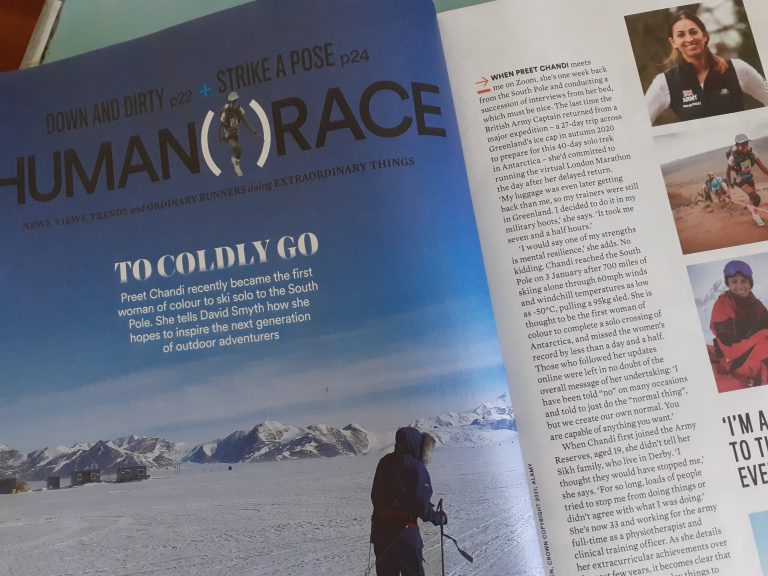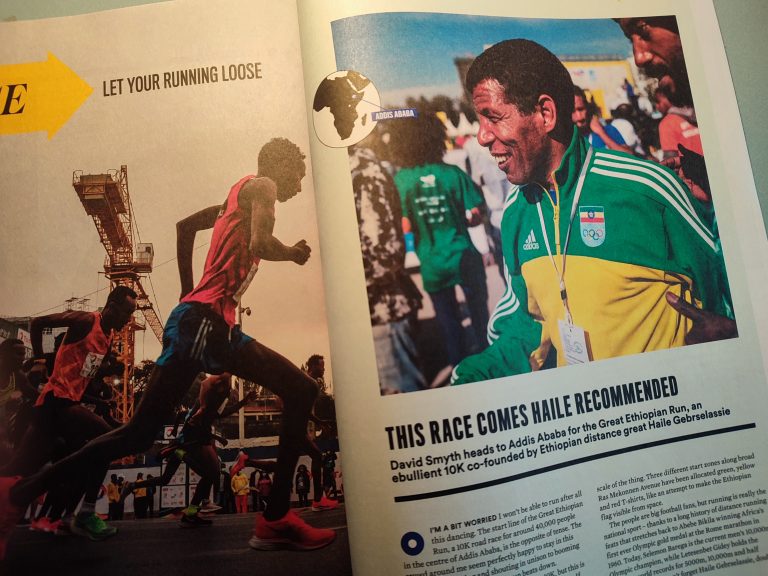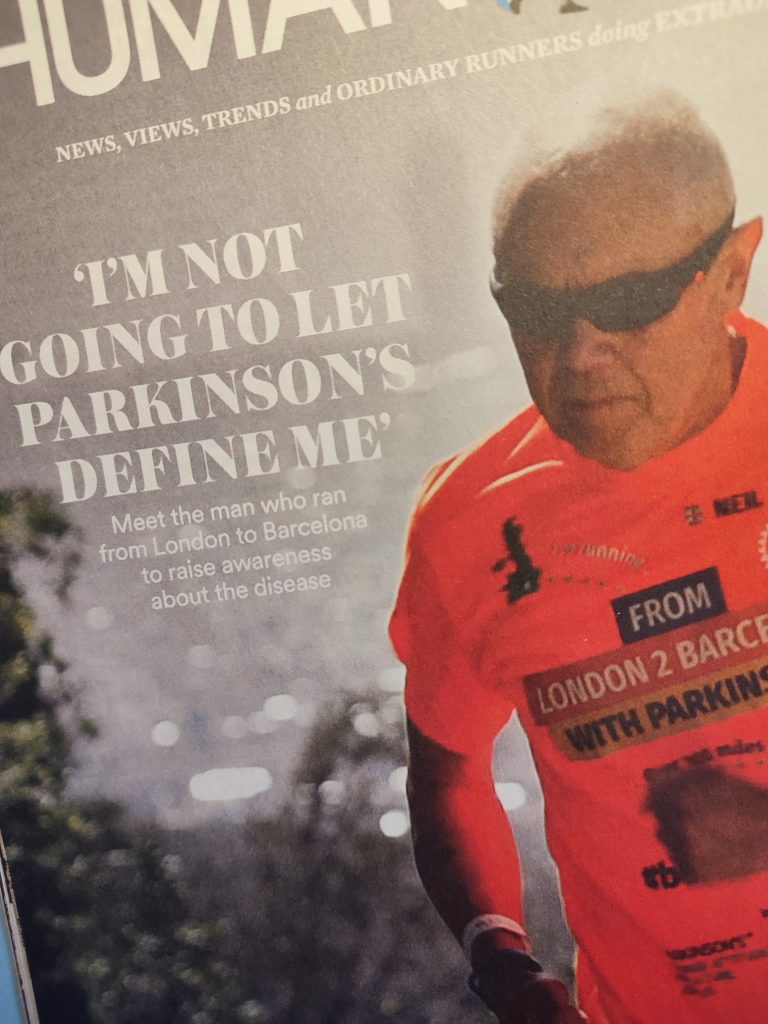ADVENTURES IN THE RUNNING METAVERSE – Runner’s World, July 2025 issue
What have your running highlights been lately? I helped a small girl to escape from marauding zombies, then watched a goblin compete in a 5k race on the streets of New Jersey. I followed my significantly better-looking twin on a jog around central London, dodged pirates and smugglers in a 23rd Century post-apocalyptic wasteland, and played hide and seek with ghosts on a university campus. Pretty impressive, huh? No wonder a knight told me that my name ‘will inspire awe whenever heard!’
Of course, none of this was entirely real, but it was a bit real, which has made for a pretty discombobulating few weeks. My usual, happily combobulated self has been running in the metaverse, spending time in an alternate reality, or extended reality – an array of techy ways that clever folks have developed to ‘gamify’ running and make our sport more engaging. The journey has led me from Victorian theatrical trickery to French philosophy via cryptocurrency and talking lamp posts. I’m a bit overwhelmed by it all to be honest.
It began when I saw an advert asking for runners to participate in a game called Can You See Me Now? that was taking place at Sussex University’s Attenborough Centre for the Creative Arts. It was conceived by Blast Theory, a collective specialising in ‘interactive art’ and theatre experiences who have previously created an immersive game featuring 1,000 people texting each other about a fictional town overrun by soldiers, and another where a series of phone calls instructs an unwitting participant to travel around a real city planning a bank heist. Can You See Me Now? was one of the earliest location-based games, way back in 2001 when tech limitations made it significantly more complicated to put on. In 2024 they revived it for mobile phones.
Myself and five others are handed a phone, some headphones and a hi-vis jacket. On the phone is a digitised map of the university campus, which shows where you are as you move around. Meanwhile, online, a larger number of players are moving avatars around the same map on their computers. Our job is to ‘catch’ the online people by occupying the same spot in reality that they are in on the computer. I must look pretty silly dashing around in circles trying to grab someone who isn’t actually there in front of me. Several real-life students stop to ask me what on earth I’m up to. My friend Steve Dampney-Jay, who is doing it with me, is staring so intensely at the phone map while he runs that he misses a step and sprains his ankle.
What makes it feel more real (apart from agonising ankle pain) is that we can talk to each other. The online players can hear the runners taunting them through the headphone microphones, and they can respond via text messages on the phone screen. I can’t resist telling one victim: ‘Now you sleep with the fishes,’ Mafia-style, when I catch them beside a pond. We are also asked to share a photo of the real spot whenever we catch someone, another bridge between the real and virtual worlds for the players.
Nick Tandavanitj from Blast Theory, who conceived the game, isn’t a runner himself and isn’t interested in it from a fitness perspective. He’s fascinated by what happens to our brains when we effectively exist in two places simultaneously. He has also worked on academic papers with Nottingham University’s Mixed Reality Laboratory, at the forefront of the field known as ‘Human-Computer Interaction’.
‘There have been these augmented reality games like Pokémon Go and Ingress that might be a bit less popular now than they were a decade ago, but they did lay the groundwork for this sense that the spaces that we physically inhabit have opportunities for things other than the things that are obviously there,’ he explains. ‘At Blast Theory we do want to reassert the physical world, as opposed to living entirely in the metaverse. I think what’s interesting is what technology can bring to the real world in terms of how it changes our perception of it.’
We talk about Pepper’s Ghost, a Victorian illusion technique popularised by John Henry Pepper at a London production of a Charles Dickens play. By projecting a figure from offstage onto a pane of glass, they appear real but spirit-like, slightly transparent. There’s a long history of the unreal mixing with the real in a way that our brains will happily accept because it’s more fun to go along with it. This leads all the way to the French philosopher Jean Baudrillard, whose ideas about ‘Hyperreality’ are becoming ever more pertinent. Hyperreality is when the boundary between the real and the simulated collapses, and we accept the simulation as more real than reality itself. Even if the Apple Vision Pro headset hasn’t been a hit, society is coming closer and closer to being comfortable in a mix of the real and virtual worlds.
Most of the time, I’m an all-round cynic, suspicious of the shiny promises of new technology and also disgusted at the screentime stats on my thumb-smeared phone. I was a latecomer both to Strava and getting a Garmin watch, mainly enjoying running for the feeling of presentness I get when I’m up on the trails, skipping past tree roots and quieting my busy mind. The most exciting thing that has ever happened to me on a run is seeing a badger.
I’ve also never been much of a gamer. If I was invited over to play on the Sega Mega Drive with schoolfriends it was only because they wanted to be certain there would be someone to beat. During lockdown my family acquired a PS4 and I discovered I enjoy games with the less-than-thrilling classification ‘walking simulators’ – where you quietly explore a mysterious landscape without the imminent threat of anyone blowing your head off. Firewatch is my favourite, which casts you as a park ranger mooching around the stunningly rendered Shoshone National Forest in Wyoming while banjo music plays – basically virtual hiking.
But like most people, I have been sucked in to the datascape of heart rates, step counts and pace calculations, and now I feel simultaneously good and bad about sharing my runs online: excited when a friend has found a new route or done well in a race, but also envious when I can see that they’ve been out on a sunny day and I haven’t got time. Another mate tells me he loves running specifically because it’s the one time he can guarantee he won’t be on his phone.
So I’m not sure how I feel about tying up my shoes while waiting for a new episode in the Zombies, Run! app to download. But if I cast my mind back to Old Me, who didn’t identify so fully as a runner and felt like the whole thing was too much like hard work, maybe this would have been just the thing to get me out the door.
Zombies, Run! has been going since 2012 and has now released several hundred ‘missions’ that cast you as Runner 5, who dares to leave the walls of Abel Township to collect supplies and rescue survivors of a zombie plague. It’s a bit like listening to a lively radio play, with brief snippets being activated in your headphones every kilometre, or whatever gap you set. I liked it best when I turned on ‘chases’, which work as great interval training when a voice warns: ‘Zombies 100m… 75m… 50m,’ and you have to speed up while their moans and growls become increasingly loud in your ears.
It’s an engaging story, as it should be given that it was written by Naomi Alderman, an English author who went on to have a huge hit with her sci-fi novel The Power and its subsequent Amazon TV series. The Handmaid’s Tale creator Margaret Atwood has also written a guest mission. But it does require perhaps too much suspension of disbelief, given that the voices in your ears are describing a grim landscape that you plainly aren’t in. On one mission I am asked to accept that I am still running fast despite having collected two axes, a box of lightbulbs and a sports bra. I find it’s best to do it at night, with a headtorch, and keep your own spooky music playing in between the sound snippets. I recommend the voodoo psychedelia of Dr John’s 1968 album Gris-Gris, which sounds like it should be top of the zombie hit parade.
If you’re someone who always ends up running the same route, games like this could be a great way to stave off boredom – and there are loads. The same company was commissioned by the NHS and Department of Health to make The Walk, a story that requires you to travel the length of the UK while evading both terrorists and the Police. There’s also Marvel Move, which lets you train with superheroes including Thor and Loki, and Venture, a large collection of sci-fi and fantasy stories to play on the run.
Since 2022 there has also been a game called Dustland Runner, which is similar to Zombies, Run! in that it places you as an important character in a post-apocalyptic disaster zone. The difference here is that the more you run, the more you are paid in their cryptocurrency token, called DOSE. Theoretically this could translate into real hard cash, but in this highly volatile industry it’s hard to tell for sure. Lots of conventional games have a mechanic they call ‘play to earn’. They reward increased participation by giving you more lives, hearts, or virtual pocket money. This is ‘move to earn’ – it’s another motivation beyond the fitness itself.
I’m particularly intrigued by another app called STEPN, which requires you to buy a virtual pair of running shoes in the form of an NFT (a non-fungible token, which means that no one else has one exactly like yours) then run to earn in-game currency which you can either spend on pimping your digital trainers or cash out. A report in the business magazine Forbes in 2022 claimed that STEPN had 2.3 million monthly users with some earning $4,500 a day, although buying your first pair of trainers could also cost hundreds depending on the current value of their Sol cryptocurrency. That could still sound pretty appealing to a regular runner, though, which must be why you now need a special invite code to join the app and I can’t find one anywhere.
Carrying on exploring what’s out there in the running gamification space, there’s definitely a particular vibe going on with all the sci-fi, fantasy and apocalypse stuff. How about Fitness RPG, that lets you train a team of ‘heroes’ by increasing your step count? Or Fallout, a real life ultra race that requires you to run away from Harwell in Oxfordshire in any direction for 12 hours, to escape an app-displayed radiation cloud that is growing at a rate of 3.5mph? Meanwhile the people who brought the Crystal Maze game to life have now created Pac-Man Live in Manchester, where competitors sprint around a life-size maze evading ghosts. There’s even an app called Nerd Fitness Journey. Is all this stuff really going to get the gaming geeks running, or are the developers fighting a losing battle trying to appeal to people who would ordinarily only leave their fuggy bedrooms for a half-price sale on Warhammer figurines?
Sam Hill knows that it can work, because that’s who he was. He and Ben Barker, friends from the Design degree at Goldsmiths, University of London, were sitting in the pub one day, lamenting how unfit they were. ‘We were talking about what it would take to get us to be more active and get our heart rates up,’ he remembers. ‘We started thinking about our interest in computer games and how you could take some of the mechanics from mobile gaming, but instead of the spending or the waiting elements, have active elements instead. So rather than waiting 24 hours or spending money to get to the next level you can go for a run instead.’
They were already interested in similar ideas to Nick from Blast Theory: ‘Using technology as a layer over physical space,’ and were developing another project called Hello Lamp Post, which lets people scan QR codes on everyday public objects and ask questions to digital assistants. For runners, they created Run an Empire, which earned a lot of buzz when it was first pitched in 2014, reaching its Kickstarter funding target in only 27 days. This game divides a map into hexagons, which become yours if you run through them the most. It’s like Strava’s Local Legend reward (which came later), favouring consistency over speed, but here you can plant fancy banners all over the territory you rule and eventually use points to build a whole city. ‘You get to be a kingly person,’ Sam says, admitting that this particular game of thrones can be ‘engaging to some people but also quite alienating to others.’
These days he prefers their other game, Stride, which uses the same map but purifies the experience simply into collecting coloured map hexes. ‘Empire is more of a Couch to 5k thing, to encourage people who maybe haven’t been active at all. Stride is more for people that are already running, maybe looking to mix things up a little bit and have a reason to go down a different path than they normally do. It’s about being the most dogged and determined, going out more often than everyone else.’
My main problem with it is that there currently aren’t enough people using it where I live to make it competitive. Strava seems to have swallowed up all the local runners. However a similar land grabbing game called Terra launched recently in Australia, and its developers say the city of Melbourne is now a hive of territory-tussling users. Permanently shirtless Instagram influencer Louis Phillips is the director, while Jordan Hesse is the developer. They made a coaching app called INTVL to share training plans, but it’s since they added Terra to it that growth has been ‘exponential’, Louis says. ‘The response to the game has been crazy. It’s building so fast that we’re just trying to keep up.’
The pair looked to the success of non-running apps, especially the language learning tool Duolingo, for ways to keep people coming back. App developers want to achieve ‘stickiness’. Duolingo’s streaks and XP (experience points) do an incredible job of making something that has traditionally felt like a chore become an enjoyable knowledge snack that millions consume daily. ‘Earning points and achieving status is a massive thing,’ says Louis. ‘People are craving it.’
With the role-playing games, you’re listening, and in the territory games, you’re finding out what you achieved when you get home. What about playing on the move? A new company called Xpriential is turning running’s most tedious variety, the treadmill, into something significantly more fun. They’re in six states in the US so far and growing fast, so it shouldn’t be long before one of their large video screens and see-sawing treadmills is sitting in a gym near you.
Sid Raman approached his invention with one thought: ‘Treadmills suck for trail runners.’ He came up with one that can change its incline almost instantly between 26% and –6%, and a screen with a camera on top that allows you to expore real mapped topography by holding your arm out left or right, like you indicate on a bike. You speed up by holding up your right hand and slow down with your left. This allows you to run while playing what Chief Commercial Officer Jeff McManus calls their ‘tribute’ to Mario Kart, or a game called Infinite Castle where you jog down corridors collecting coins and dodging giant smashing hands. The device can also display the exact scenery and gradients of famous marathon courses, allowing you to train for a big race on the official route, or theoretically compete on the treadmill against the real runners on race day. And, of course, you can run as an avatar of a goblin if you wish.
Thanks to a six-month-old tech company called HOVVA, which isn’t yet on the market, I finish my adventure sitting in a St James’s Park café watching an avatar of myself running the same route I was travelling in real life not 10 minutes earlier. My digital twin has smoother skin, better posture and proudly sports a skin-tight unitard that would make those around me recoil in horror in the real world. But there he is, cruising past a Buckingham Palace instantly rendered with the help of Google Maps 3D tiles, just like I did moments before.
HOVVA’s CEO, Beth Hodge, describes what they do with the mouthful: ‘We’re a real-time, digital twin, gamified endurance sport broadcast platform.’ This is a technology to help spectators watch your race while it’s happening – think a significantly more interesting version of the ‘dot watching’ that people sometimes do today – or for you to relive your run and all its accompanying data after it’s over. ‘We’re pulling in live data and visualising it in our augmented world,’ she adds. ‘In a big event, people could follow 10 runners that they know and watch a little race going on within the race.’ The imagery is a little blocky for now, especially of trees in close up, but I’m still blown away by the way the virtual camera leaps in and out from bird’s-eye views to close-ups, with the familiar London architecture all around.
It feels like the future, if that’s what you want. I’m still torn about whether all these virtual worlds are giving me something that I genuinely need in addition to the world I actually live in. I talk to my friend Steve, a lover of both running and technology, about what we’d really love to see: ‘Running and gaming are two very different things, and right now, they don’t integrate seamlessly,’ he says. ‘You have to keep looking at your phone, then looking up to run, then stopping again. Until they can fully merge – maybe through augmented reality glasses that show the towers and zombies in real-time – these experiences might always feel disjointed and frustrating.’
Sam from Run an Empire/Stride adds: ‘You could do a lot of interesting stuff with AI, maybe making narrative decisions when you come upon literal crossroads.’ It feels like we must be close to a time when an AI narrator could know that you’re running up a steep hill in real life and adapt a story accordingly. And what if, instead of a zombie, you could see an avatar of you on your fastest day, and race yourself to a new PB?
Sounds exciting, but it’s important to remember something else: I actually love running, just as it is. I put on my trainers, leave my watch and phone on the kitchen counter and head outside into glorious high definition reality, hoping for another badger.
